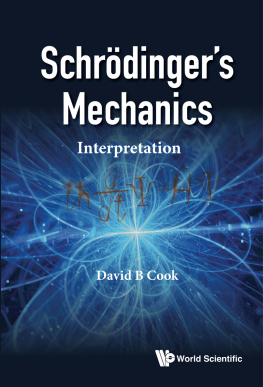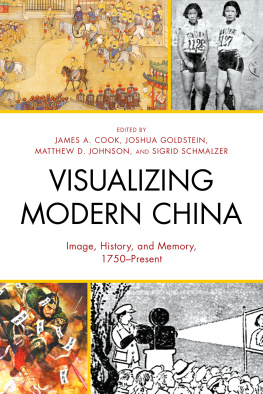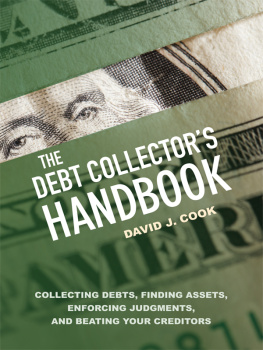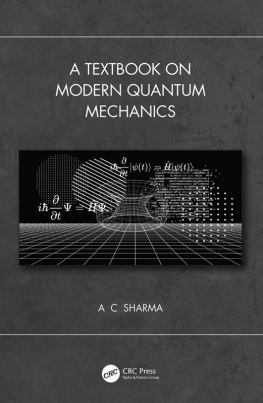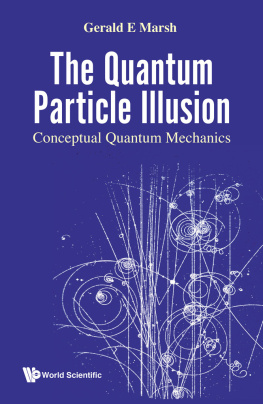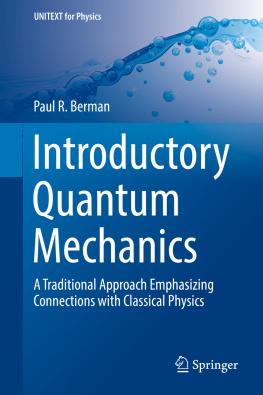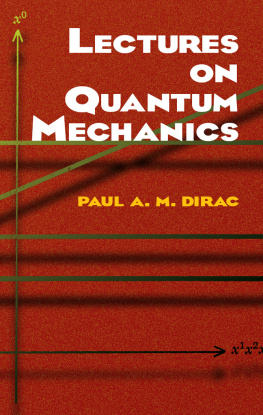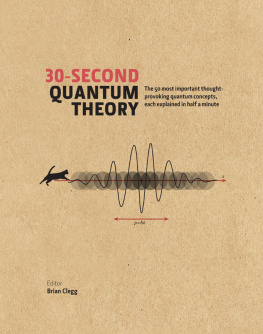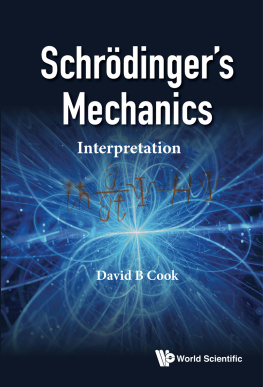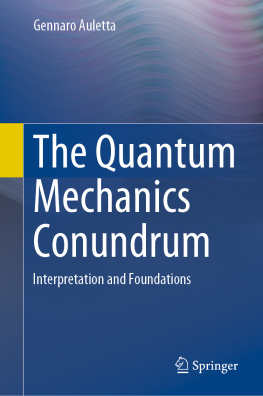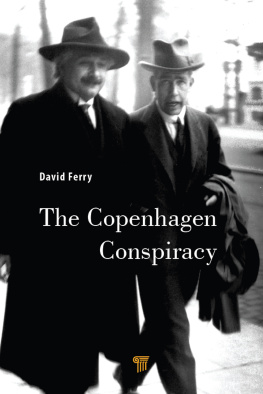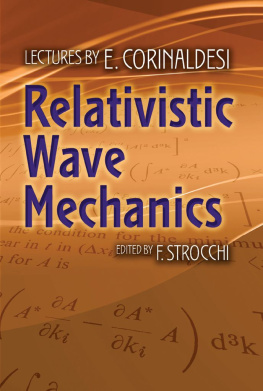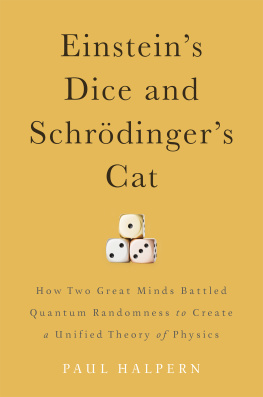Contents
Pagebreaks of the print version
Schrdingers
Mechanics
Interpretation
Other World Scientific Titles by the Author
Schrdingers Mechanics
ISBN: 978-9971-5-0760-2
Probability and Schrdingers Mechanics
ISBN: 978-981-238-191-0
Quantum Chemistry: A Unified Approach
Second Edition
ISBN: 978-1-84816-746-9
Schrdingers
Mechanics
Interpretation
David B Cook
University of Sheffield, UK

Published by
World Scientific Publishing Europe Ltd.
57 Shelton Street, Covent Garden, London WC2H 9HE
Head office: 5 Toh Tuck Link, Singapore 596224
USA office: 27 Warren Street, Suite 401-402, Hackensack, NJ 07601
Library of Congress Cataloging-in-Publication Data
Names: Cook, David B. (David Branston), author.
Title: Schrdingers mechanics : interpretation / by David B. Cook
(University of Sheffield, UK).
Description: New Jersey : World Scientific, 2018.
Identifiers: LCCN 2017052617 | ISBN 9781786344908 (hc : alk. paper)
Subjects: LCSH: Wave mechanics. | Schrdinger equation. | Schrdinger operator. |
Quantum theory. | Numerical analysis.
Classification: LCC QC174.26.W28 C6574 2018 | DDC 530.12/4--dc23
LC record available at https://lccn.loc.gov/2017052617
British Library Cataloguing-in-Publication Data
A catalogue record for this book is available from the British Library.
Copyright 2018 by World Scientific Publishing Europe Ltd.
All rights reserved. This book, or parts thereof, may not be reproduced in any form or by any means, electronic or mechanical, including photocopying, recording or any information storage and retrieval system now known or to be invented, without written permission from the Publisher.
For photocopying of material in this volume, please pay a copying fee through the Copyright Clearance Center, Inc., 222 Rosewood Drive, Danvers, MA 01923, USA. In this case permission to photocopy is not required from the publisher.
For any available supplementary material, please visit
http://www.worldscientific.com/worldscibooks/10.1142/Q0143#t=suppl
Desk Editors: Herbert Moses/Jennifer Brough/Koe Shi Ying
Typeset by Stallion Press
Email:
Printed in Singapore
Preface
There is no shortage of books about the interpretation of quantum theories; they range from the what do I need to know type to fantastic and unverifiable conjectures about the nature of the universe(s), why should one get involved in such a knotty area of dispute? What I would like to do in this short account is to emphasise that the original form of Quantum Mechanics is not a series of useful formulae for interpreting experimental results nor does it require any new philosophies, it is a cogent interpreted theory of the behaviour of sub-atomic particles and has been as successful in this region as Newtons mechanics has been in the familiar world. In this context we academics all write, in our Mission Statements and our Self-evaluations of Teaching, that we encourage, even insist on, a critical, scientific attitude to learning. But where is this critical attitude encouraged and what type of criticism is to be elicited from our students?
Of course, we encourage a critical attitude to the quality and reliability of experimental data error analysis and all that but this is just routine, little more than a formalisation of common sense and good housekeeping. Only very rarely is a criticism of the theories of science and their interpretation encouraged and if it is, this criticism is to be found in formal courses in History and Philosophy of Science and not in the real everyday process of confronting current science in our teaching and research. One is reminded of the saying every generation must write history anew for itself; much lip service and very little practice. In fact, if every generation of scientists does not rework the theories which they have been taught for themselves (at least in outline) then science stagnates and becomes a set of recipes; just another set of axioms to be manipulated.
This work is the outcome of many years mostly post-retirement of musing about quantum mechanics and its interpretation. In this, I have been mainly influenced by what I have called elsewhere Schrdingers Mechanics (henceforth SM); the mechanics developed by Schrdinger in his astonishing paper of 1926. During these years I have come to realise more and more the absolutely central importance of the method developed in this paper. I shall want to say more about the strange fact that this paper is now largely unread and the methods used in it apparently unknown. So, this work could be described as old hat in that it is almost a century since this pioneering publication; but the disagreements about the interpretation of SM and all of the quantum mechanics which followed is certainly not so antique, indeed it is an open sore in physics.
In previous publications I have concentrated on the non-relativistic SM while occasionally promising to have a more careful look at the problem of making quantum mechanics compatible with Special Relativity, that is to see how to introduce Lorentz invariance onto the scene. Special Relativity has played hardly any part in my professional research (quantum chemistry) and I have always had a strong suspicion that the idea that electron spin somehow depends on Special Relativity is suspect. This is naturally due to my prejudice, as a chemist, against Diracs physical interpretation of his pretty mathematics.
In this work I will show that, when equipped with a realistic interpretation, the methods of Schrdingers 1926 paper contain either explicitly or implicitly all other formulations of Quantum Mechanics. And I use contain deliberately; SM is not equivalent to other formulations, it includes them in the sense that many principles (axioms) of other methods are theorems in SM. What is true, however, is that SM shares some formal (mathematical) structures with other theories; but that is extremely common in mathematically articulated sciences; all that this means is that certain formal mathematical structures may be abstracted from SM. What makes SM unique is its physical interpretation and its explicit and transparent links to Classical Particle Mechanics. With the historical development of methods allegedly based on or derived from SM has come a retreat from physical interpretation in general and the very idea of submitting ones theories to independent verification is often abandoned. In criticising the standard interpretations of quantum theories I am very aware of the possible shortcomings of such work as aptly described by Kenneth Tynans definition: A critic is a man [sic] who knows the way but cant drive the car.
A word or two about my eccentricities: I use the word abstract as both an adjective and, more often, as a verb. Also, I have purposely tended to refer to older publications since these earlier authors were struggling to understand the meaning of all the new theories in science not simply to work from what are regarded as standard interpretations. I have used appendices and endnotes as well as the occasional footnote; footnotes are indicated by the traditional symbols (*, etc.) and the endnotes, which tend to be longer, by numbers. I hope that the book could be read simply by reading the chapters leaving appendices and endnotes for some clarification. Some principle points are repeated or referred to from time-to-time for the reader who, like myself, tends to dip into a book without reading from the start!

